Resuscitation of a tester of Marcus
Santa Claus put me a tester of electronic components under the Christmas tree in the form of a Chinese clone of the tester Marcus, widely known in narrow circles.

There should have been a picture of the tester turned on with a screen joyfully shining with all the colors of the rainbow, but hands from one place stuck a charged capacitor in it, the tester happily switched on, said “oh!” And refused to work.
Sorry, damn it. Let's try to repair.
1. We go to the Yandex-disk with schemes and firmware for all clones known to the community . Fortunately, the TS-1 clone is already there.
2. We study the circuit and board of the tester, experimentally find out that there is a short circuit (short circuit) on the + 5V bus.

If the tester switched itself on when the capacitor was connected, then the power was supplied to the bus either through the built-in reverse diodes at the microcontroller inputs, or through the protective assembly DZ2.
We solder DZ2, the assembly is alive, the short circuit is in place. So the worst thing happened, the microcontroller burned out.
3. We order the Atmega644 microcontroller, the TQFP-44 case, 2 pieces, in case something goes wrong.
4. While Atmega is traveling from China, we prepare the tools and look for the programmer.
We will need:

4.1. Soldering station, a set of tips for a soldering iron, a "third hand" with a magnifier, thin-thin tweezers, good flux (Chinese, but liquid, which is better than rosin), a little bit of solder.
Programmers (thanks to Int_13h for giving away a whole box of all sorts of different ones):
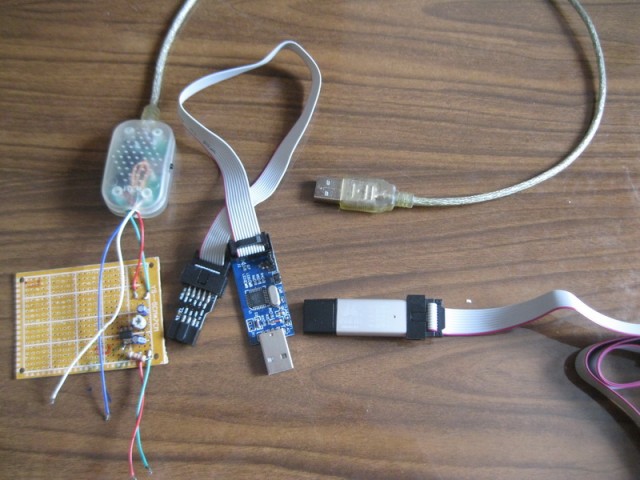
4.2. USBasp without housing for Atmega, with 10 pin to 6 pin ISP adapter.
4.3. USB ISP in the case for Atmega (you will never guess which one is useful).
4.4. A USB / UART 5V converter from some kind of mobile phone for flashing the U4 power controller (STC15L104W).
Because the controller loves 3.3V, at the assembly we assemble a 5-> 3.3V stabilizer based on the LM1117:
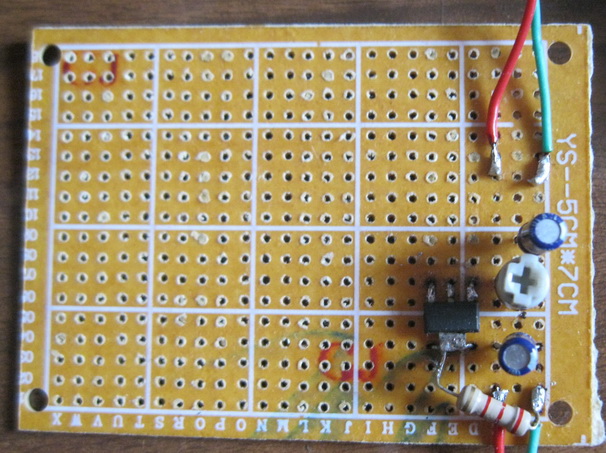
It turns out that the stabilizer does not work without load. We hang a resistor at the output, for example 2.2 kOhm. We install exactly 3.3 V at the output using a voltmeter and potentiometer.
5. Finally, they waited for the envelope with microcontrollers.
6. We remove the burned microcontroller with a hairdryer, clean the contact pads, lubricate with a flux, and solder a new one. With a thin sting, each leg. But first in the corners. They say it’s possible with a hairdryer, but there is no solder paste.

For the first time, even beautifully.
At the same time, solder the connector for in-circuit programming. We make sure the wiring for the adapter 10to6 is correct, solder the connector to the other side of the board.
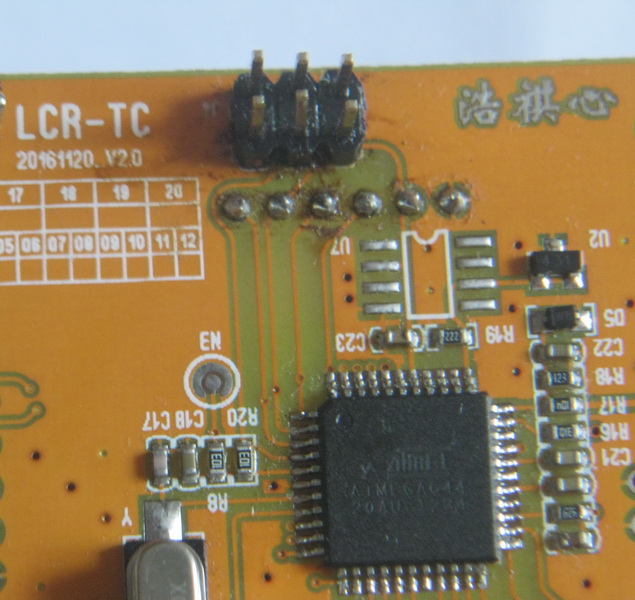
And of course we provide a battery connector. Total:
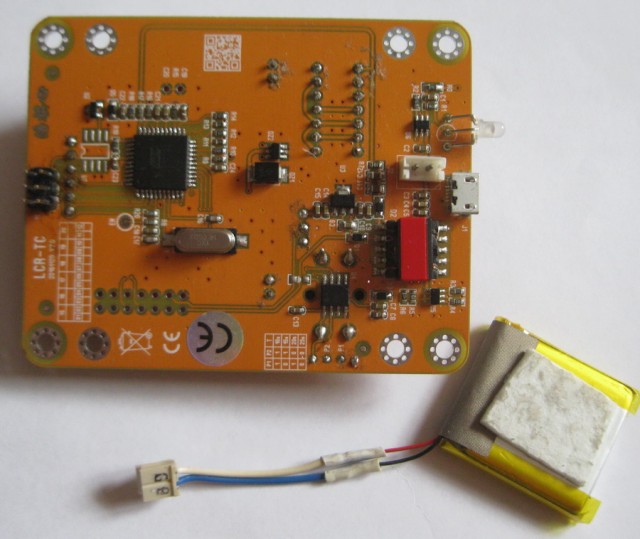
7. We are preparing to flash the U4 power controller. Solder the USB-UART converter with stabilizer to the board:
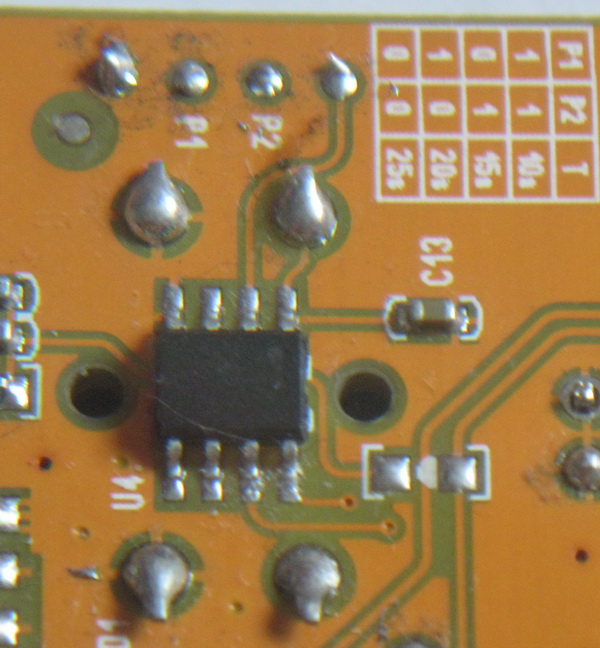
3.3V to 3.3V, Gnd to Gnd, Tx to P1, Rx to P2.
8. We are looking for software stc-isp6.86.rar on the manufacturer’s website .
9. Connect the converter, wait for it to be detected by the system, start the software, select the com-port, select the firmware from the archive (item 1), set the frequency to 12 MHz, apply power, the processor starts, does not go into boot mode, the programmer does not detect .
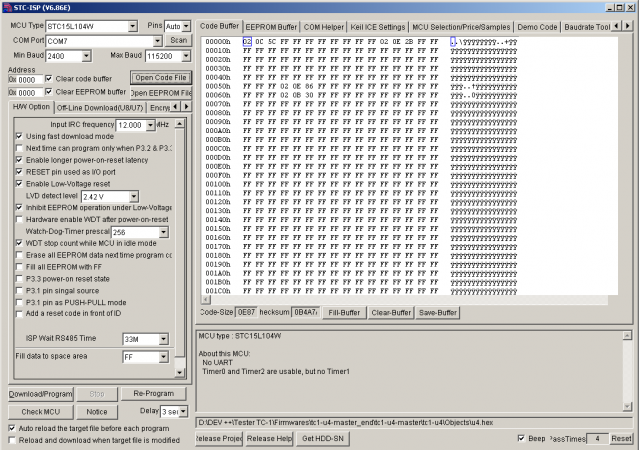
9.1. We experiment with the sequence of power supply to the processor and by pressing the “Check MCU” & “Download / Program” buttons.
9.2. We study the datasheet on U4, we find that the Test button of the tester is connected to the Reset pin. Click "Check MCU", click the Test button, the microcontroller resets and is detected. In the same way, run the firmware, and finally, flash the U4.
10. We study the abundance of software for Atmega firmware.
10.1. We install the powerful and convenient Atmel Studio 6.2, we find that it does not support USBasp and USB ISP programmers. Demolish.
10.2. We are looking for Avrdude and the graphical shell for it. Of all the abundance, we dwell on the intuitive Avrdude_prog 3.3, which understands USBasp, understands the firmware * .hex and * .eep, and is able to clearly show the selected fuses. We connect, run:

Oblom-s, the programmer has too old firmware.
10.3. This is where USB ISP comes in, the software of which is not so friendly, but it is capable of flashing the programmer. Or maybe the tester will flash it? Alas:
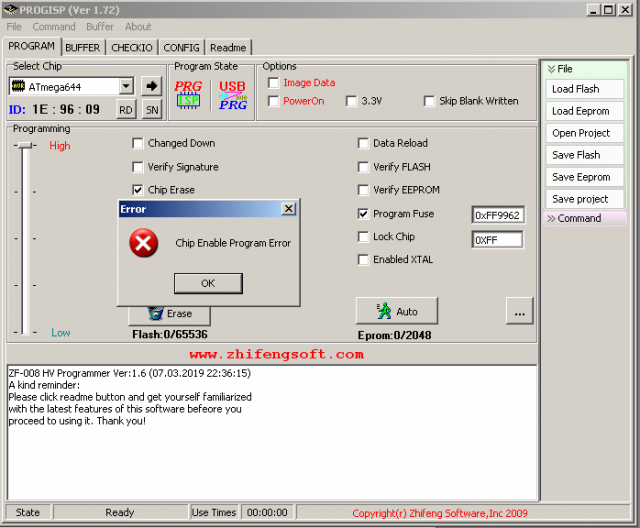
10.4. We are looking for fresh firmware on USBasp, we connect USB ISP and USBasp with a cable, we close the J1 jumper on USBasp, entering it in programming mode. Fill the firmware. Success!
10.5. Inspired by success, we are also trying to flash USB ISP in USBasp. We solder the jumper onto the board according to the methodology, first backup the firmware and fuses.
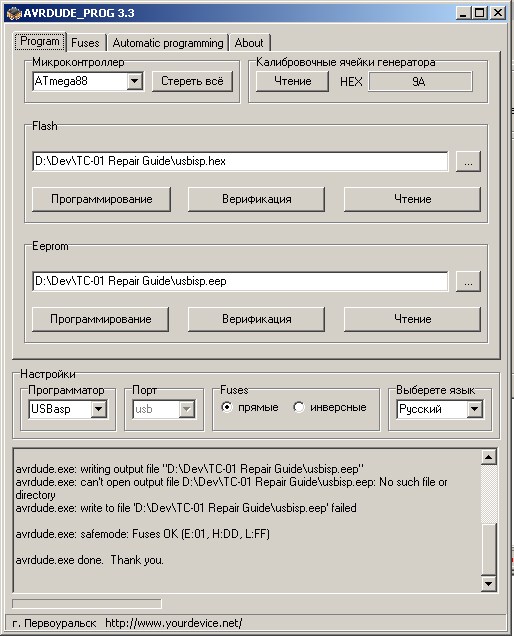

10.6. We sew.

Solder the jumper. We connect the former USB ISP to the computer and do not detect it with software. Maybe confusion with fusion? Then we'll figure it out. Sorry! But you have fulfilled your goal and so far you can rest in peace.
10.7. Goto 10.2. But now our programmer is already sewing Atmega successfully.
11. We are worried about the success of the operation.
12. Launching the tester. Bingo!
Measurements are taking place, but there were some shortcomings as well - the tester turns off almost instantly after the measurement process, and you may not have time to take readings.
In the next series: attempts to make their own firmware for the tester to eliminate the effect of instant shutdown. The firmware will be based on the sources of Marcus . And also, as I tried, but could not fall in love with AVR.

There should have been a picture of the tester turned on with a screen joyfully shining with all the colors of the rainbow, but hands from one place stuck a charged capacitor in it, the tester happily switched on, said “oh!” And refused to work.
Sorry, damn it. Let's try to repair.
1. We go to the Yandex-disk with schemes and firmware for all clones known to the community . Fortunately, the TS-1 clone is already there.
2. We study the circuit and board of the tester, experimentally find out that there is a short circuit (short circuit) on the + 5V bus.

If the tester switched itself on when the capacitor was connected, then the power was supplied to the bus either through the built-in reverse diodes at the microcontroller inputs, or through the protective assembly DZ2.
We solder DZ2, the assembly is alive, the short circuit is in place. So the worst thing happened, the microcontroller burned out.
3. We order the Atmega644 microcontroller, the TQFP-44 case, 2 pieces, in case something goes wrong.
4. While Atmega is traveling from China, we prepare the tools and look for the programmer.
We will need:

4.1. Soldering station, a set of tips for a soldering iron, a "third hand" with a magnifier, thin-thin tweezers, good flux (Chinese, but liquid, which is better than rosin), a little bit of solder.
Programmers (thanks to Int_13h for giving away a whole box of all sorts of different ones):

4.2. USBasp without housing for Atmega, with 10 pin to 6 pin ISP adapter.
4.3. USB ISP in the case for Atmega (you will never guess which one is useful).
4.4. A USB / UART 5V converter from some kind of mobile phone for flashing the U4 power controller (STC15L104W).
Because the controller loves 3.3V, at the assembly we assemble a 5-> 3.3V stabilizer based on the LM1117:

It turns out that the stabilizer does not work without load. We hang a resistor at the output, for example 2.2 kOhm. We install exactly 3.3 V at the output using a voltmeter and potentiometer.
5. Finally, they waited for the envelope with microcontrollers.
6. We remove the burned microcontroller with a hairdryer, clean the contact pads, lubricate with a flux, and solder a new one. With a thin sting, each leg. But first in the corners. They say it’s possible with a hairdryer, but there is no solder paste.

For the first time, even beautifully.
At the same time, solder the connector for in-circuit programming. We make sure the wiring for the adapter 10to6 is correct, solder the connector to the other side of the board.

And of course we provide a battery connector. Total:

7. We are preparing to flash the U4 power controller. Solder the USB-UART converter with stabilizer to the board:

3.3V to 3.3V, Gnd to Gnd, Tx to P1, Rx to P2.
8. We are looking for software stc-isp6.86.rar on the manufacturer’s website .
9. Connect the converter, wait for it to be detected by the system, start the software, select the com-port, select the firmware from the archive (item 1), set the frequency to 12 MHz, apply power, the processor starts, does not go into boot mode, the programmer does not detect .

9.1. We experiment with the sequence of power supply to the processor and by pressing the “Check MCU” & “Download / Program” buttons.
9.2. We study the datasheet on U4, we find that the Test button of the tester is connected to the Reset pin. Click "Check MCU", click the Test button, the microcontroller resets and is detected. In the same way, run the firmware, and finally, flash the U4.
10. We study the abundance of software for Atmega firmware.
10.1. We install the powerful and convenient Atmel Studio 6.2, we find that it does not support USBasp and USB ISP programmers. Demolish.
10.2. We are looking for Avrdude and the graphical shell for it. Of all the abundance, we dwell on the intuitive Avrdude_prog 3.3, which understands USBasp, understands the firmware * .hex and * .eep, and is able to clearly show the selected fuses. We connect, run:

Oblom-s, the programmer has too old firmware.
10.3. This is where USB ISP comes in, the software of which is not so friendly, but it is capable of flashing the programmer. Or maybe the tester will flash it? Alas:

10.4. We are looking for fresh firmware on USBasp, we connect USB ISP and USBasp with a cable, we close the J1 jumper on USBasp, entering it in programming mode. Fill the firmware. Success!
10.5. Inspired by success, we are also trying to flash USB ISP in USBasp. We solder the jumper onto the board according to the methodology, first backup the firmware and fuses.


10.6. We sew.

Solder the jumper. We connect the former USB ISP to the computer and do not detect it with software. Maybe confusion with fusion? Then we'll figure it out. Sorry! But you have fulfilled your goal and so far you can rest in peace.
10.7. Goto 10.2. But now our programmer is already sewing Atmega successfully.
11. We are worried about the success of the operation.
12. Launching the tester. Bingo!
Measurements are taking place, but there were some shortcomings as well - the tester turns off almost instantly after the measurement process, and you may not have time to take readings.
In the next series: attempts to make their own firmware for the tester to eliminate the effect of instant shutdown. The firmware will be based on the sources of Marcus . And also, as I tried, but could not fall in love with AVR.
